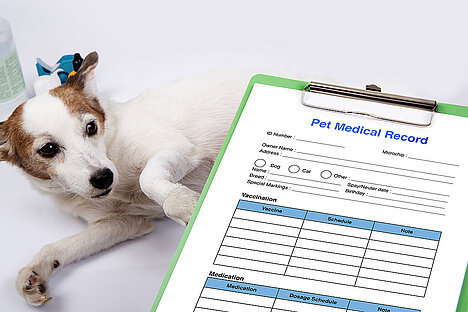Hip joint prosthesis

If your dog suffers from hip dysplasia, a hip replacement may be a possible treatment option. In this article, you'll find out what a hip replacement is, how it works, what the benefits and risks are and how to care for your dog after the operation.
What is a hip joint prosthesis?
A hip joint prosthesis is an artificial joint that replaces your dog's diseased or damaged hip joint. The hip joint consists of a spherical head on the thigh bone and a cup-shaped socket on the pelvic bone. With hip joint dysplasia, these two parts do not fit together properly, which leads to pain, inflammation and osteoarthritis.
A hip joint prosthesis consists of a metal head, which is attached to the thigh bone, and a plastic socket, which is screwed onto the pelvic bone. These two parts slide together with little friction, allowing the hip joint to move normally.
How does a hip joint prosthesis work?
A hip joint prosthesis is inserted in an operation that is performed under general anesthesia. The vet makes an incision in your dog's hip and separates the muscles and ligaments surrounding the joint. He then removes the diseased or damaged joint head and socket and replaces them with the artificial parts. The muscles and ligaments are sutured back together and the incision is closed.
The operation usually takes about two hours per side. If both sides are affected, the operation can be performed either at the same time or in two separate sessions. Your dog will need to stay in the veterinary clinic for a few days after the operation to recover and receive painkillers.
What are the advantages of a hip joint replacement?
A hip replacement can significantly improve your dog's quality of life by giving them freedom from pain and more mobility. Most dogs can walk, run and play normally again after a successful operation. A hip joint prosthesis can also slow or stop the progression of osteoarthritis by reducing friction in the joint.
A hip joint prosthesis is a permanent solution to the problem of hip joint dysplasia. The artificial parts are designed to withstand wear and tear and do not need to be replaced. The success rate of a hip joint prosthesis is over 90 percent.
What are the risks of a hip joint prosthesis?
As with any operation, there are also some risks with a hip joint prosthesis that you should be aware of. The possible complications include
- Infections: An infection can occur at the surgical site or in the joint itself. This can lead to pain, swelling, fever and pus. An infection must be treated with antibiotics and, in rare cases, can lead to the prosthesis having to be removed.
- Loosening: The prosthesis can loosen or shift over time, which can lead to instability, pain or lameness. Loosening can be caused by trauma, overloading or poor bone quality. Loosening may require corrective surgery.
- Dislocation: The prosthesis may slip out of position or dislocate, causing pain or lameness. Dislocation can be caused by trauma, hyperextension or insufficient healing. Dislocation can sometimes be corrected manually or require corrective surgery.
- Nerve damage: Surgery can injure or pinch the nerves that supply the hind leg. This can lead to numbness, weakness or paralysis. Most nerve damage heals on its own or with physical therapy, but some can be permanent.
- Bleeding: Surgery can cause bleeding in the surgical area or joint. This can lead to pain, swelling or anemia. Most bleeding stops on its own or with pressure dressings, but some may require a blood transfusion or further surgery.
The overall risks of hip replacement are low and can be minimized with careful selection of a veterinarian, good preparation and proper aftercare.
How do you care for your dog after surgery?
Caring for your dog after surgery is very important to ensure a quick and full recovery. The most important aspects of aftercare include
- Pain management: your dog will be given pain medication after surgery, which you will need to continue at home. Follow your vet's instructions carefully and never give your dog medication that has not been prescribed for them. Watch your dog for signs of pain, such as panting, whimpering, trembling or aggression. If you think your dog is in pain, contact your vet.
- Wound care: Keep the surgical site clean and dry. Avoid touching or licking the wound. Check the wound daily for signs of infection, such as redness, swelling, warmth or pus. If you suspect an infection, contact your vet. Your dog will probably need to wear a collar to prevent them from nibbling at the wound. Follow your vet's instructions regarding the removal of stitches or staples.
- Exercise restriction: Your dog will need to restrict his activity for at least six weeks after surgery. Allow him only short leash walks to relieve himself and avoid climbing stairs, jumping, running or playing. Keep your dog away from slippery surfaces and provide him with a soft surface to lie on. Follow your vet's instructions regarding gradually increasing exercise.
- Physiotherapy: Your dog will benefit from physiotherapy to strengthen his muscles, improve his mobility and relieve his pain. Your vet will show you exercises you can do with your dog at home, such as massage, passive movement or hydrotherapy. You can also consult a professional animal physiotherapist who can create a personalized treatment plan for you.
A hip joint prosthesis is an effective and safe treatment for dogs with hip dysplasia. If you choose this option, you can look forward to a better quality of life for your dog.
The authors assume that a veterinarian should be consulted if an animal is ill and that medication should only be taken after consultation with a doctor or pharmacist. Only an individual examination can lead to a diagnosis and treatment decision.
We help you find the nearest vet → This way